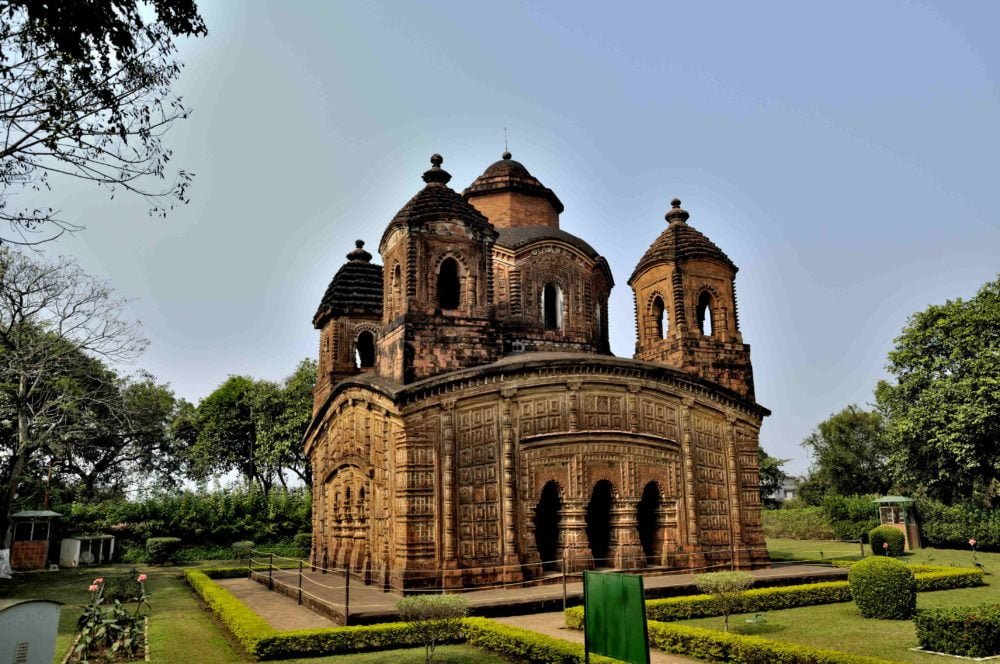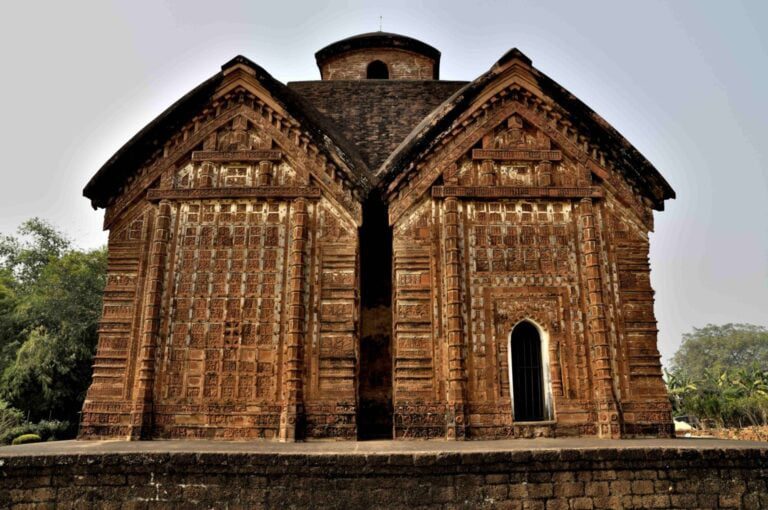Pancharatna Temple, or Pancha Ratna, in Bishnupur is also known as the Shyam Rai Temple. It was built by King Raghunath Singha in the year 1643. Pancharatna Mandir is built on a low, square base, and there is a path that leads to a porch with three arches on each of the four sides of the temple. The middle shikhara is round, while the other four are square. Beautiful terracotta carvings on the walls show Lord Krishna’s life.
Pancharatna Temple
The Pancharatna Temple honors Vishnu as Krishna. It is built in the Pancharatna style and may be the oldest Pancharatna-style temple still standing in West Bengal. In Bengali, Panchratna means “five gems.” This is why it has five towers. The Shyam Rai temple is made entirely of brick, which was the only building material that was easy to find in the area at the time. It has a low square base and a char chala roof with ratnas, or gems, on each corner.
The corner towers are square, while the tower in the middle is octagonal. They are set up in a “Pida” shape on a roof that slopes down. On each of the temple’s four sides, there are triple-cusped arched entrances that lead to the sanctum, which is surrounded by a well-paved road.
The Pancharatna temple, like the other temples in the Bishnupur subdivision of the Bankura district in West Bengal, has a curved cornice and eaves that are based on the bamboo huts with thatched roofs that are common in Bengal. This shape is a direct descendant of the homes’ bamboo frames, which were bent into this shape to drain water when it rained often and hard.
The architects and craftspeople of the time didn’t care that there was no stone or any other building material. Instead, they baked stories into clay tiles that told stories from mythology and real life. By pouring life into bricks, they made a new kind of temple building that led to the creation of terracotta temples with ornate and intricate terracotta reliefs.
Since bricks were used to build, the typical column-and-beam style of early Islamic buildings could not be used. So, arches have been used to fill in the spaces and hold up the weight above. Most of the other temples in Bishnupur have flat ceilings, but the Shyam Rai temple has a curved ceiling that was inspired by Islamic design.
Pancharatna Temple Bishnupur Location
The Pancharatna temple in Bengal was the first of its kind. It had statues and flower designs that were very pretty. It has many beautiful terracotta sculptures on its walls and ceilings. These sculptures show Krishna Leela, scenes from the Ramayana and Mahabharata, and the social, economic, and political life of the time.
The rasa mandala is especially beautiful because it shows how aesthetic and structural knowledge can work together. A few pieces of Gandhara-style sculpture are on the walls. The beautiful terracotta tiles are thought to have been made by people from the nearby villages of Uliwara and Panchmura.
Before the Archaeological Survey of India took it over in 1996, the temple was in bad shape and had been robbed. Since a long time ago, the idol of Lord Krishna has been in Bishnupur. During Holi, the idol is brought back for five days and worshiped here. This makes the complex a busy place.
The temples of Bishnupur, in the Indian state of West Bengal, have been on the UNESCO Tentative List since 1998. According to the List of Monuments of National Importance in West Bengal, the Pancharatna Temple is on the ASI list (Series No. N-WB-31). Date of Submission: July 3, 1998. Category: Cultural. Submitted by: Archaeological Survey of India.
Sadly, Bengal has always been underprivileged since the British left. Hence, the Archaeological Survey of India is not moving it forward further. So, even after 25 years, it is still on the tentative list of UNESCO. Let’s read what UNESCO says on its website anyway.
Most of the temples at Bishnupur are of the Eka-Ratna type, which has a single tower on a sloped roof and a square cell (Garbhagriha) with three multicusped arches on each side. These temples are made of brick and laterite (i.e., Lalji, Kalachand, Radhashyam, Jormandir, and Nandalal). There are a few others with more than one Pancha Ratna type tower (Shyam Rai of A.D. 1643).
The Jor Bangle temple was built in the year 1655. It has two Dochala structures that are joined at the top by a Charchala Sikhara. The Rasmancha, built around 1600, has a unique style of architecture. It has a pyramidal roof and a large laterite base. The sanctum is surrounded by three galleries that go around it.




